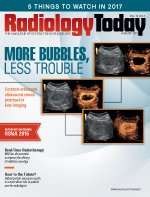 January 2017
January 2017
Inside View: Hyperloop May Accelerate Specialized Care
By José Morey, MD, and Nora Haney
Radiology Today
Vol. 18 No. 1 P. 11
Society's reaction to technological advancement seems to follow a familiar pattern: At first, groundbreaking changes are rejected; the horse and buggy, the train, and the cell phone were all groundbreaking inventions that disquieted society when they were introduced.1 Society's perception of these technologies often changes, however, and many have become staples of everyday life.
One such technological advancement that could raise similar alarms is the Hyperloop. The concept was introduced by Elon Musk, who made it public by publishing a white paper via his Space Exploration Technologies Corporation, also known as SpaceX.2 The original Hyperloop concept describes a high-speed transportation modality with the goal of traveling from San Francisco to Los Angeles in only 30 minutes. While neither SpaceX nor Musk are involved in the creation of its prototype, multiple private companies have taken up the gauntlet. To demonstrate, SpaceX hosted a Hyperloop Pod Competition in the summer of 2016.
One group, called HyperloopOne, who focuses on cargo transportation, held a demonstration on May 11, 2016, of their novel electromagnetic propulsion system to show acceleration from 0 to 60 mph in 1 second, generating a force of about 2.5G.3 Hyperloop Transportation Technologies (HTT), a separate company working specifically on a Hyperloop prototype, licensed the propulsion system from Lawrence Livermore National Labs to use in HTT's creation of their Hyperloop. While science fiction novels have fantasized about this type of travel, how many of your patients would you deem physically fit for it?
Blue et al subjected untrained commercial passengers to centrifuge G-force, with the conclusion that most individuals with controlled medical conditions can withstand forces needed to undergo spaceflight.4 Nausea, palpitations, headache, disequilibrium, and chest discomfort were commonly reported and resolved quickly. It should also be noted that the participants were subjected to accelerations as high as 6G, twice that of an astronaut during launch and more than 10 times what is planned for the commercial Hyperloops. So, while our knee-jerk reaction may be to dither on a recommendation for our portly patients with a gamut of comorbidites, it very likely will be okay to send them home from the hospital quickly and efficiently via the Hyperloop.
Fast-Track Success
While this technology can understandably create medical unease, what else can high-speed transportation allow physicians to do? A new mode of transportation will be transformational to both society and all medical specialties. More patients may be able to receive highly specialized care they need. For example, patients who were once considered to be in underserved areas will no longer be considered as such, due to minuscule travel time to a tertiary care center with 24-hour specialized radiology.
All parties involved, including physicians, nurses, ancillary staff, patients, and their families will have a smaller number of barriers to travel to centrally located medical facilities. Practices will have an expanded competition pool and market size. Groups will likely have to merge to remain competitive. The cost of living will go down due to expanded city size and the intertwining of cities. Geographic disparities, which currently plague resources such as organ transplantation, can be greatly improved.5
Making geography smaller will allow medicine to reach farther than it can today. The conception of the Hyperloop, while daring, can clearly benefit society and the delivery of health care, but it will also change what this delivery looks like. For example, radiologists could live in the mountains or countryside and commute within minutes into the city of their choice, improving their overall quality of life as well as that of their patients.
And as with very few radical innovations before, the public has an opportunity to get involved. Thus, how will we, as future and present-day physicians, stay current—or maybe even ahead of the game—and use this technology to advocate for our patients? For example, with the transformation of health care reimbursement from volume- to value-based care, access to preventive care is becoming increasingly important. Physicians and the accountable care organization umbrellas under which they work have more at stake with regard to transportation and community planning. Innovative infrastructure such as the Hyperloop could be of monumental importance toward decreasing the costs of satellite clinics and small-scale community health outreach by obviating the need for them. By engaging in the orchestration of technological logistics, physicians are in a unique position to help even more patients than ever before.
— José Morey, MD, is a senior medical scientist for IBM Research, a visiting assistant professor in the department of radiology and medical imaging at the University of Virginia, medical technology and artificial intelligence officer for NASA iTech, senior engineer specialist for Hyperloop Transportation Technologies, a member of the Health Informatics Leadership Council at the VA, and a radiologist at the VA in Norfolk, Virginia.
— Nora Haney is an MD/MBA candidate at the Tulane University School of Medicine and AB Freeman School of Business in New Orleans.
References
1. Koebler J. It doesn't matter that Americans are scared of new technology. Motherboard website. http://motherboard.vice.com/read/it-doesnt-matter-that-americans-are-scared-of-new-technology. Published April 18, 2014.
2. Hyperloop Alpha. SpaceX website. http://www.spacex.com/sites/spacex/files/hyperloop_alpha-20130812.pdf
3. Macdonald F. Watch the first full-scale demonstration of hyperloop technology. Science Alert website. http://www.sciencealert.com/watch-the-first-full-scale-demonstration-of-hyperloop-technology. Published May 12, 2016.
4. Blue RS, Riccitello JM, Tizard J, Hamilton RJ, Vanderploeg JM. Commercial spaceflight participant G-force tolerance during centrifuge-simulated suborbital flight. Aviat Space Environ Med. 2012;83(10):929-934.
5. Increasing equity in liver transplants. US Department of Health & Human Services, Organ Procurement and Transplantation Network website. https://optn.transplant.hrsa.gov/governance/policies/policy-initiatives/evolution-of-liver-allocation-and-distribution/

